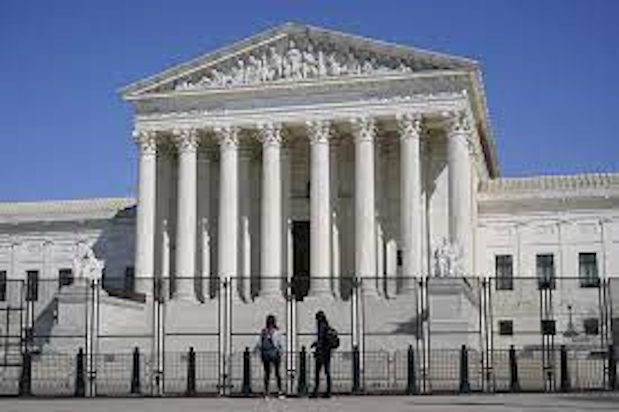
EPA’s WOTUS scheme deep-sixed by Supreme Court: (Inside the Sackett decision exposing Obama and Biden scheme for federal zoning of untold millions of acres of private land.)
In one of the most consequential judicial decisions in recent memory, the U.S. Supreme Court May 25 significantly limited the Environmental Protection Agency’s (EPA) authority to regulate wetlands under the Clean Water Act (CWA).
Ending decades of regulatory uncertainty over what was meant when the 1972 CWA authorized EPA (and the U.S. Army Corps of Engineers) to regulate discharges into “navigable waters of the United States” (WOTUS), the High Court – in a decision written by Justice Samuel A. Alito – provided clarity over how non-navigable waters, specifically wetlands, are to be treated.
With the United States containing hundreds of millions of acres of wetlands – some of them permanently wet, others ephemeral, but none of them navigable – the unresolved question of EPA’s regulatory authority has hung like a sword of Damocles over farmers, ranchers, and other landowners. If EPA determined that farmer Brown’s agricultural operations posed a threat to nearby wetlands – even if those wetlands had no connection, or only a tenuous connection, to navigable water — he could be slapped with fines so stiff that the survival of his farm was in jeopardy.
In fact, you didn’t even have to be a farmer to be put through the EPA WOTUS ringer. The case that triggered the May 25 ruling involved Michael and Chantell Sackett, who set out 16 years ago to build a home on their 0.63-acre lot near Priest Lake, Idaho. The couple had just started backfilling operations when EPA agents showed up demanding they cease construction or face fines of up to $40,000 a day. Their otherwise bone-dry property’s only connection to a wetland and eventually to navigable water was a subsurface stream that connected to a ditch, which connected to a creek, which flowed into Priest Lake, 300 feet from the Sacketts’ property line.
WOTUS and the Rise of the Administrative Regulatory State
The Sacketts’ absurd situation shows what can happen when the language of laws is so vague that agencies charged with enforcing them believe they can interpret their writ any way they wish. This has been a boon to the administrative regulatory state, which has thrived in recent decades because unelected and unaccountable bureaucrats wind up writing rules and regulations that have the force of law behind them.
After the Supreme Court in two decisions – from 2000 and 2005 – failed to deliver regulatory clarity, the Obama and Biden administrations issued rules giving EPA broad authority to regulate wetlands. But federal courts threw out key sections of the Obama rule, and the Trump administration issued its own rule in 2020, which limited the scope of EPA’s authority. The Biden White House scrapped the Trump rule and issued its own rule in January of this year. But the Biden rule is now a dead letter after the High Court’s May 25 ruling.
“We hold that the CWA extends to only those wetlands with a continuous surface connection to bodies that are ‘waters of the United States’ in their own right, so that they are ‘indistinguishable’ from those waters,” Alito wrote for the court.
“Regulation of land and water use lies at the core of traditional state authority,” Alito explained. “An overly broad interpretation of the CWA’s reach would impinge on this authority. The area covered by wetlands alone is vast – greater than the combined surface area of California and Teas. And the scope of EPA’s conception of ‘waters of the United States’ is truly staggering.”
Alito also laid to rest then-Justice Anthony Kennedy’s ill-defined test of a “significant nexus” to a navigable water to determine whether EPA could regulate a wetland.
“By the EPA’s own admission, nearly all waters and wetlands are susceptible to regulation under this test, putting a staggering array of landowners at risk of criminal prosecution for such things as moving dirt,” he pointed out.
The court further circumscribed EPA’s and the Corps’ power by — for the first time — drawing a clear distinction between wetlands that “adjoin” a covered water and those which are merely “adjacent” to it. Regulatory authority extends to the former but not to the latter.
The 1972 CWA was designed to ensure that the nation’s waterways were clean, and it has been largely successful in achieving that goal. But, thanks to vague language relating to the regulation of non-navigable waters, the statute was hijacked and transformed into a means to regulate land use. Both the Obama and Biden administrations sought to use the uncertainty over the scope of EPA’s regulatory authority over WOTUS to impose a scheme for federal zoning of untold millions of acres of private land. The Supreme Court has now blocked that effort.
Author
Bonner Cohen, Ph. D.
Bonner R. Cohen, Ph. D., is a senior policy analyst with CFACT, where he focuses on natural resources, energy, property rights, and geopolitical developments. Articles by Dr. Cohen have appeared in The Wall Street Journal, Forbes, Investor’s Busines Daily, The New York Post, The Washington Examiner, The Washington Times, The Hill, The Epoch Times, The Philadelphia Inquirer, The Atlanta Journal-Constitution, The Miami Herald, and dozens of other newspapers around the country. He has been interviewed on Fox News, Fox Business Network, CNN, NBC News, NPR, BBC, BBC Worldwide Television, N24 (German-language news network), and scores of radio stations in the U.S. and Canada. He has testified before the U.S. Senate Energy and Natural Resources Committee, the U.S. Senate Environment and Public Works Committee, the U.S. House Judiciary Committee, and the U.S. House Natural Resources Committee. Dr. Cohen has addressed conferences in the United States, United Kingdom, Germany, and Bangladesh. He has a B.A. from the University of Georgia and a Ph. D. – summa cum laude – from the University of Munich.
From cfact.com